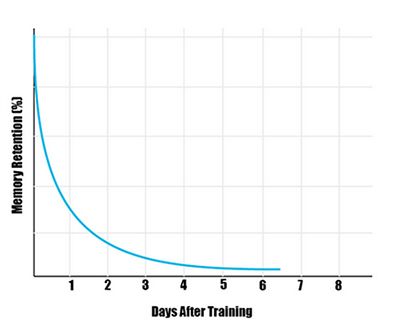Is Your Prospect's Memory Recall As Bad As Yours From Corporate Training?
This rather unglamorous drop-off is a Forgetting Curve. Long ago I came across the seed of these kinds of data, the Ebbinghaus effect.
It creates a decay theory for how much info is lost and when, given the passage of time since you first took it in.
As you can see from the above graph, there is a depressingly exponential fade of intake.
Recently, I glimpsed a huge MNC’s attempts to cascade an initiative throughout their organisation.
The aim struck me as noble. The core of the plan spread in a simple video. Under ten minutes in length, it featured a talker alongside gradually revealing flipchart “loops”.
The issue I had, was that how ever worthy the intel, there was simply too much to take in.
A brand new way of thinking. One which took practitioners years to perfect. Proponents surely could not expect viewers to take it all on board and correctly implement straight away. It felt like trying to take your driving test after only reading a car’s manual. And we’re not all like Arnie in the 80s film Twins.
Over the years I’ve certainly found the best ‘training’ sessions deal with a singular behaviour wherever possible with immediate chance to practice, refine and embed once outside the teaching room.
The days of a two-day dedicated program of sessions surely over.
Is this a lesson for ‘educating’ prospects?
How often are we guilty of cramming too much pitch into a single call?
Not only this, but what about the tactics suggested to reverse the collapse to forgetfulness?
One of my favourites is the “booster”.
Training pros advocate a kind of end-of-class quiz. Revisiting the idea again a day or two later. And the biggie, that principle of ‘use it or lose it’, ensuring that continual reinforcement subsequently takes place in the workplace.
It is this last one that is the killer in Sales. It’s really, really tough to make happen.
Let’s deal with one of these concepts for now. The booster.
You’ve probably heard the tip that what you do after the meeting is more important than what you did in the meeting. The same rings true for training. And slightly tangentially, memes abound about the real sales fortune is made in the follow-up.
You simply must have good reason, already established, to carry on dialogue once you’ve left prior the next major meeting.
Checking figures. Confirming stances. Designing collateral. Specing options. Choosing scenarios.
There’s a whole host of roads to travel to “reshape the forgetting curve”.
Whichever you choose, make it one that drums in the key ‘learning’ you want your prospect to adopt.

